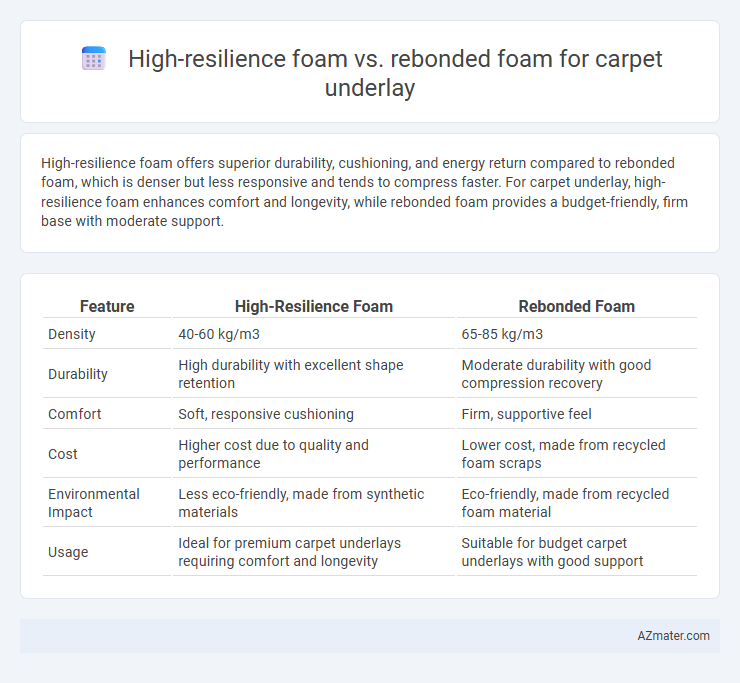High-resilience foam offers superior durability, cushioning, and energy return compared to rebonded foam, which is denser but less responsive and tends to compress faster. For carpet underlay, high-resilience foam enhances comfort and longevity, while rebonded foam provides a budget-friendly, firm base with moderate support.
Table of Comparison
| Feature | High-Resilience Foam | Rebonded Foam |
|---|---|---|
| Density | 40-60 kg/m3 | 65-85 kg/m3 |
| Durability | High durability with excellent shape retention | Moderate durability with good compression recovery |
| Comfort | Soft, responsive cushioning | Firm, supportive feel |
| Cost | Higher cost due to quality and performance | Lower cost, made from recycled foam scraps |
| Environmental Impact | Less eco-friendly, made from synthetic materials | Eco-friendly, made from recycled foam material |
| Usage | Ideal for premium carpet underlays requiring comfort and longevity | Suitable for budget carpet underlays with good support |
Introduction to Carpet Underlay Options
High-resilience foam offers superior durability and cushioning, ideal for maintaining carpet shape and comfort in high-traffic areas. Rebonded foam, made from shredded foam scraps bonded together, provides firm support and excellent density at a more budget-friendly price. Choosing between high-resilience and rebonded foam depends on factors like foot traffic, comfort preference, and budget requirements for carpet underlay.
What is High-Resilience Foam?
High-resilience foam is a type of polyurethane foam known for its superior elasticity, durability, and support, making it an excellent choice for carpet underlay. Unlike rebonded foam, which is composed of shredded foam scraps glued together, high-resilience foam offers consistent density and long-lasting cushioning that maintains its shape under heavy foot traffic. It enhances carpet comfort, improves insulation, and extends the life of flooring by providing effective shock absorption and resistance to wear.
What is Rebonded Foam?
Rebonded foam is a dense, durable carpet underlay made from shredded scrap foam pieces bonded together with adhesive, providing firm support and long-lasting performance. It offers superior cushioning and noise insulation compared to traditional foam types, making it ideal for high-traffic areas. High-resilience foam tends to be more flexible and resilient, while rebonded foam delivers enhanced stability and weight-bearing capacity for robust underlay solutions.
Key Differences Between High-Resilience and Rebonded Foam
High-resilience foam offers superior durability and consistent cushioning due to its open-cell structure, providing better support and longer lifespan compared to rebonded foam. Rebonded foam is made from shredded scrap foams compressed together, resulting in a denser, firmer underlay that excels in heavy-duty applications but may lack the elasticity of high-resilience foam. The key differences lie in performance: high-resilience foam enhances comfort and bounce-back, while rebonded foam prioritizes firmness and cost-effectiveness for high-traffic areas.
Comfort and Support Comparison
High-resilience foam offers superior durability and elasticity, providing consistent support and enhanced comfort by quickly regaining its shape under pressure, making it ideal for carpet underlays in high-traffic areas. Rebonded foam, made from shredded foam pieces bonded together, delivers firm support but lacks the same level of responsiveness and cushioning, resulting in a denser feel that may reduce comfort over time. The choice between high-resilience and rebonded foam greatly impacts the underlay's ability to absorb impact, maintain carpet shape, and contribute to long-term comfort and support.
Durability and Lifespan
High-resilience foam offers superior durability and a longer lifespan compared to rebonded foam due to its open-cell structure, which provides excellent elasticity and support under heavy foot traffic. Rebonded foam, made from shredded foam scraps bonded together, tends to compress faster and degrade more quickly, making it less ideal for long-term usage in carpet underlay. Choosing high-resilience foam enhances carpet performance by maintaining cushioning and structural integrity over many years.
Sound and Thermal Insulation Performance
High-resilience foam offers superior sound absorption and thermal insulation due to its open-cell structure, which effectively reduces noise transmission and retains heat. Rebonded foam, composed of shredded foam pieces bonded together, provides moderate sound insulation but typically underperforms in thermal retention compared to high-resilience foam. The dense composition of rebonded foam contributes to durability but limits its ability to insulate against temperature changes efficiently.
Installation and Maintenance Considerations
High-resilience foam offers superior elasticity and durability, making installation smoother due to its consistent density and easier compression under carpets, reducing wrinkles and uneven surfaces. Rebonded foam, composed of recycled foam scraps bonded together, may require more careful handling during installation to avoid uneven texture and firmness variations that can affect carpet appearance. Maintenance of high-resilience foam underlays typically involves less frequent replacement due to its long-lasting structural integrity, while rebonded foam might degrade faster under heavy traffic, necessitating more regular inspections and possible early replacements.
Cost Analysis: High-Resilience vs Rebonded Foam
High-resilience foam typically costs more upfront than rebonded foam due to its superior durability and comfort, making it a preferred choice for long-term carpet underlay investment. Rebonded foam offers a budget-friendly alternative by recycling foam scraps, lowering material expenses but compromising on cushioning quality and lifespan. Evaluating cost against performance, high-resilience foam provides greater value in high-traffic areas despite the higher initial expenditure.
Choosing the Right Foam for Your Carpet Underlay Needs
High-resilience foam offers superior elasticity and durability, making it ideal for high-traffic areas where comfort and long-term performance are essential. Rebonded foam, composed of shredded foam scraps bonded together, provides excellent support and affordability but may lack the consistent bounce and resilience of high-resilience foam. Choosing the right carpet underlay depends on factors like foot traffic, budget, and desired cushioning, with high-resilience foam best suited for premium comfort and rebonded foam fitting budget-conscious projects needing firm support.

Infographic: High-resilience foam vs Rebonded foam for Carpet underlay
 azmater.com
azmater.com